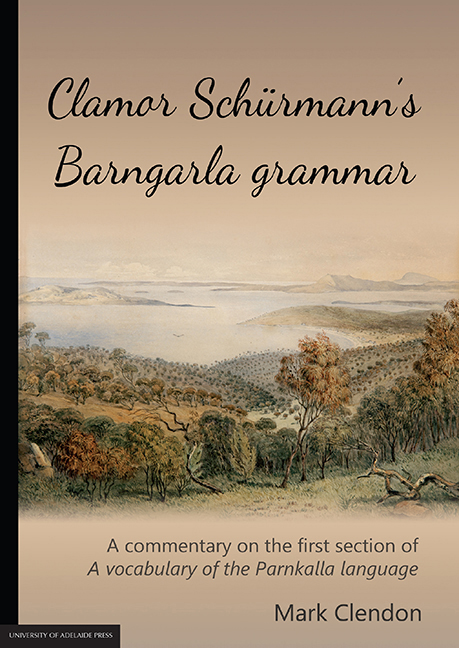 Clamor Schürmann's Barngarla grammar
Clamor Schürmann's Barngarla grammar Book contents
- Frontmatter
- Frontispiece
- Contents
- Abbreviations used in glossing sentence examples & in the text
- Preface
- Map: The northern and western Thura-Yura languages
- 1 Introduction
- 2 Writing Barngarla sounds
- 3 Pronouns
- 4 Intransitive verbs
- 5 Transitive verbs
- 6 Harry Crawford's Barngarla verbs
- 7 Suffixes on nouns
- 8 Other suffixes
- 9 Demonstrative & interrogative pronouns
- 10 Verbal derivational affixes
- 11 Non-finite verbs
- 12 Putting words together
- 13 Prospect
- Appendix The name Barngarla
- References
4 - Intransitive verbs
Published online by Cambridge University Press: 05 February 2016
- Frontmatter
- Frontispiece
- Contents
- Abbreviations used in glossing sentence examples & in the text
- Preface
- Map: The northern and western Thura-Yura languages
- 1 Introduction
- 2 Writing Barngarla sounds
- 3 Pronouns
- 4 Intransitive verbs
- 5 Transitive verbs
- 6 Harry Crawford's Barngarla verbs
- 7 Suffixes on nouns
- 8 Other suffixes
- 9 Demonstrative & interrogative pronouns
- 10 Verbal derivational affixes
- 11 Non-finite verbs
- 12 Putting words together
- 13 Prospect
- Appendix The name Barngarla
- References
Summary
Introduction
Barngarla verbs are composed of a base or root, to which are added various endings or suffixes that show when and sometimes how the event or act portrayed by the verb is being performed. Barngarla verb roots that are not derived from other words (such as nouns or adjectives) usually, or at least very often, contain two syllables. Verbs will be cited either as Schürmann cites them, in a non-past (present and future) tense shape such as ngugadha ‘go’, or as a root, like nguga- ‘go’.
Verb roots
A few apparently underived verbs discussed in this commentary show trisyllabic roots, such as: babmandi- ‘come’, yurrulbu- ‘accompany’, gurrugu- ‘be giddy’, barlaga- ‘rise’, wandhaga- ‘leave behind’ and iridni- ‘separate’. There may, however, be explanations for some of these. The segment ndi on the end of babmandi- looks like a Thura-Yura present-tense ending frozen onto the root of this verb. The segments bu and ga on the ends of yurrulbu-, wandhaga- and barlaga- look like Pama-Nyungan verb formatives likewise frozen onto these root shapes. They may be relics from a time when as verb formatives those shapes were productive in Barngarla, or they may have been borrowed more recently. The fact that the Kuyani equivalent of Barngarla wandhaga- is wantha- would tend to support the supposition that these are augmentations of what were originally disyllabic roots. The root gurrugu- is probably ideophonic. In the dictionary four underived, trisyllabic roots end in the segment mbi-, two in bma- and one in mba-, as if these shapes, too, could be, or could have been, formatives of some sort. A full review of Schürmann's vocabulary would doubtless reveal more multi-syllabic roots, and may suggest other explanations for their occurrence. For example, the four-syllable root garradyugu- ‘hold up to the wind, winnow’ is composed of the adjective garra ‘high’ prefixed to a bisyllablic root dyugu-. A further suggestion is offered at Section 10.5.2.
Transitivity
The difference between transitive and intransitive verbs is essential and basic to Barngarla grammar, and it is a point of grammar you will need to know about. Most English verbs can be given or forced into transitive expressions, although there are a few that are always, or nearly always, intransitive, such as chatter, giggle, die, sleep and snore.
- Type
- Chapter
- Information
- Clamor Schürmann's Barngarla grammarA commentary on the first section of A vocabulary of the Parnkalla language, pp. 37 - 54Publisher: The University of Adelaide PressPrint publication year: 2015
